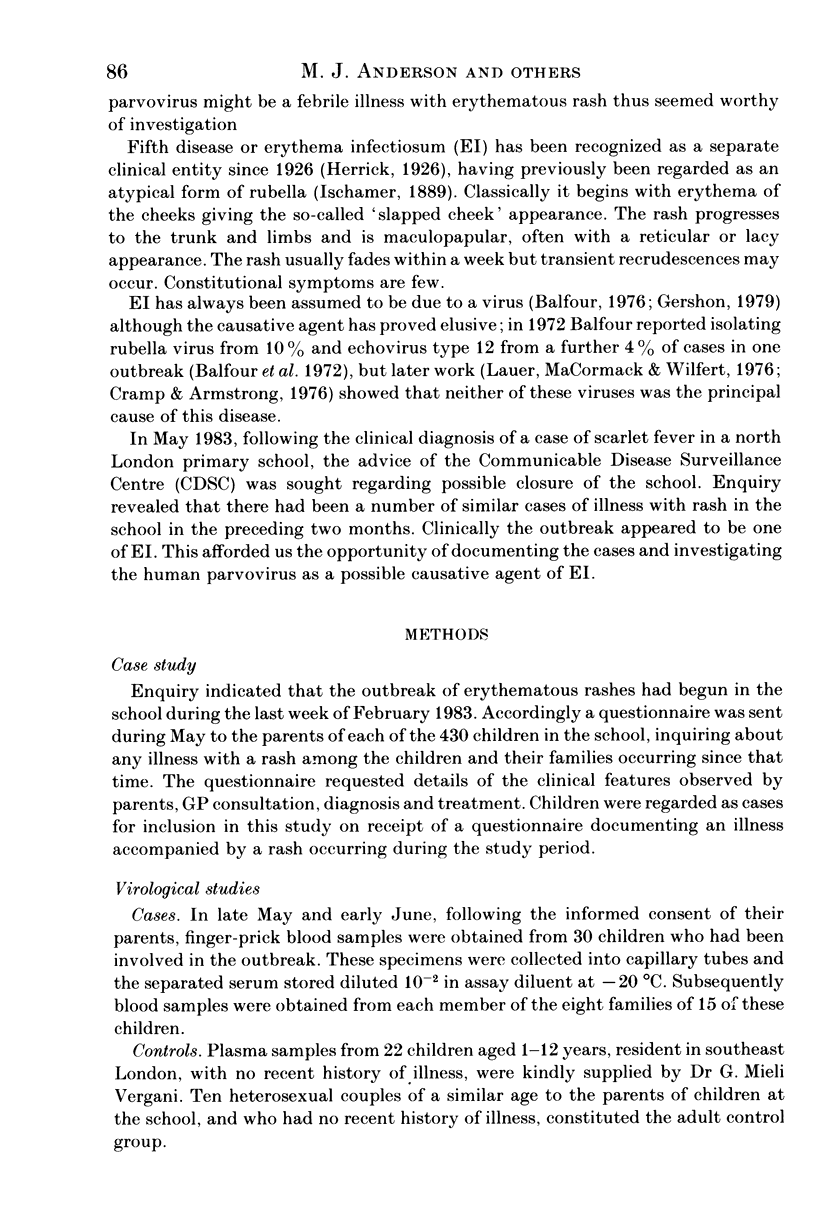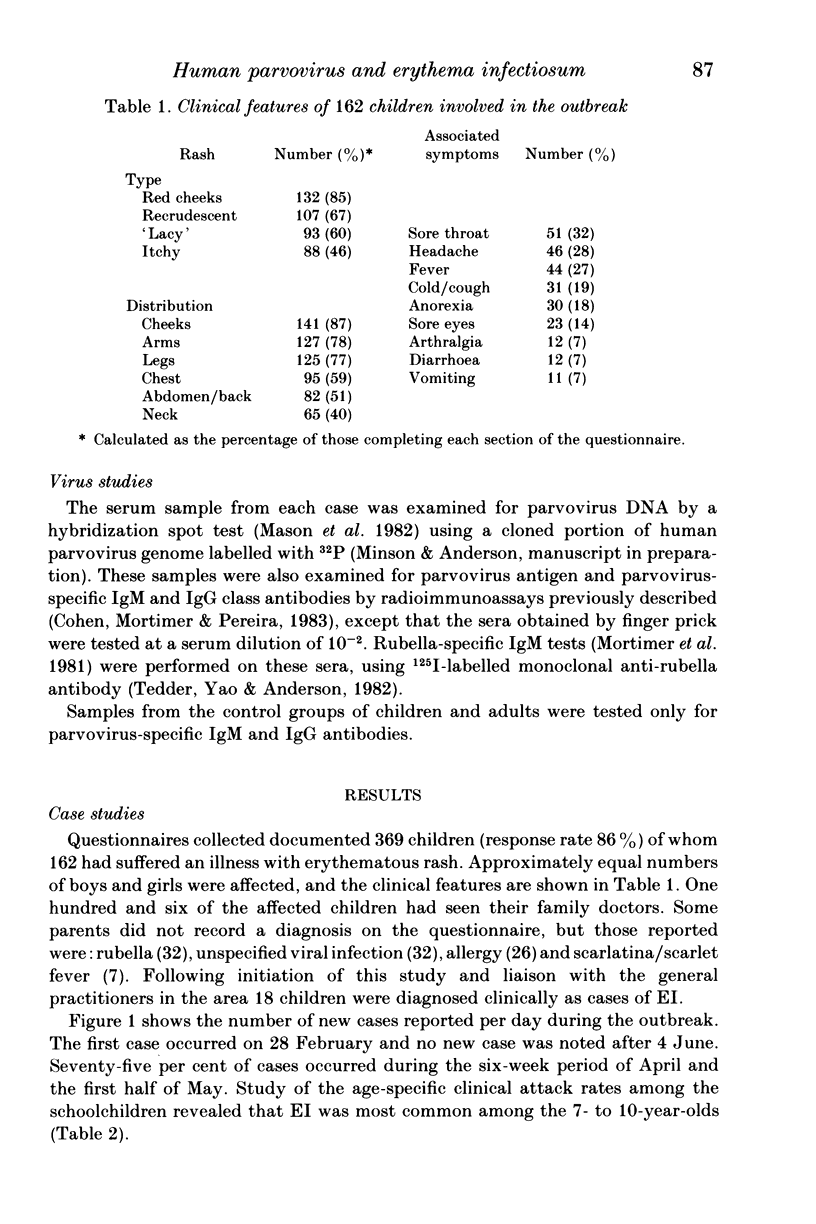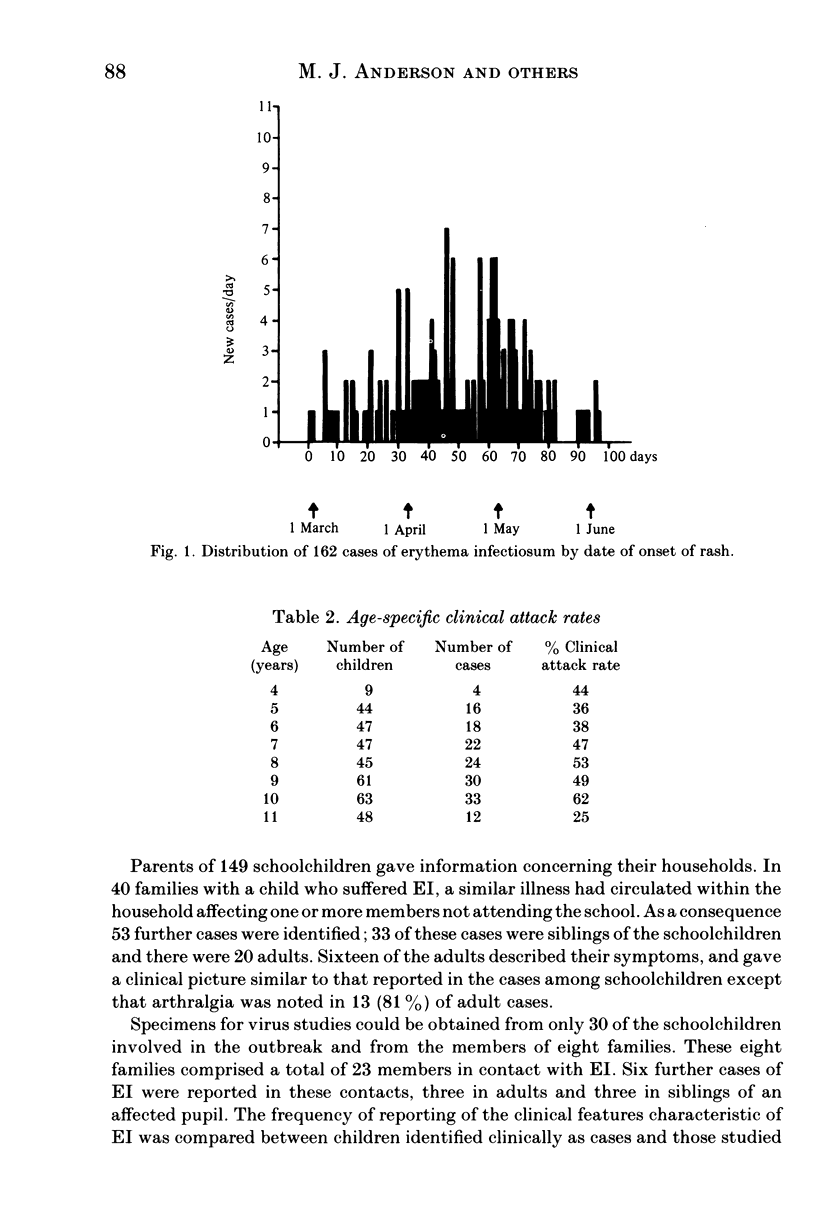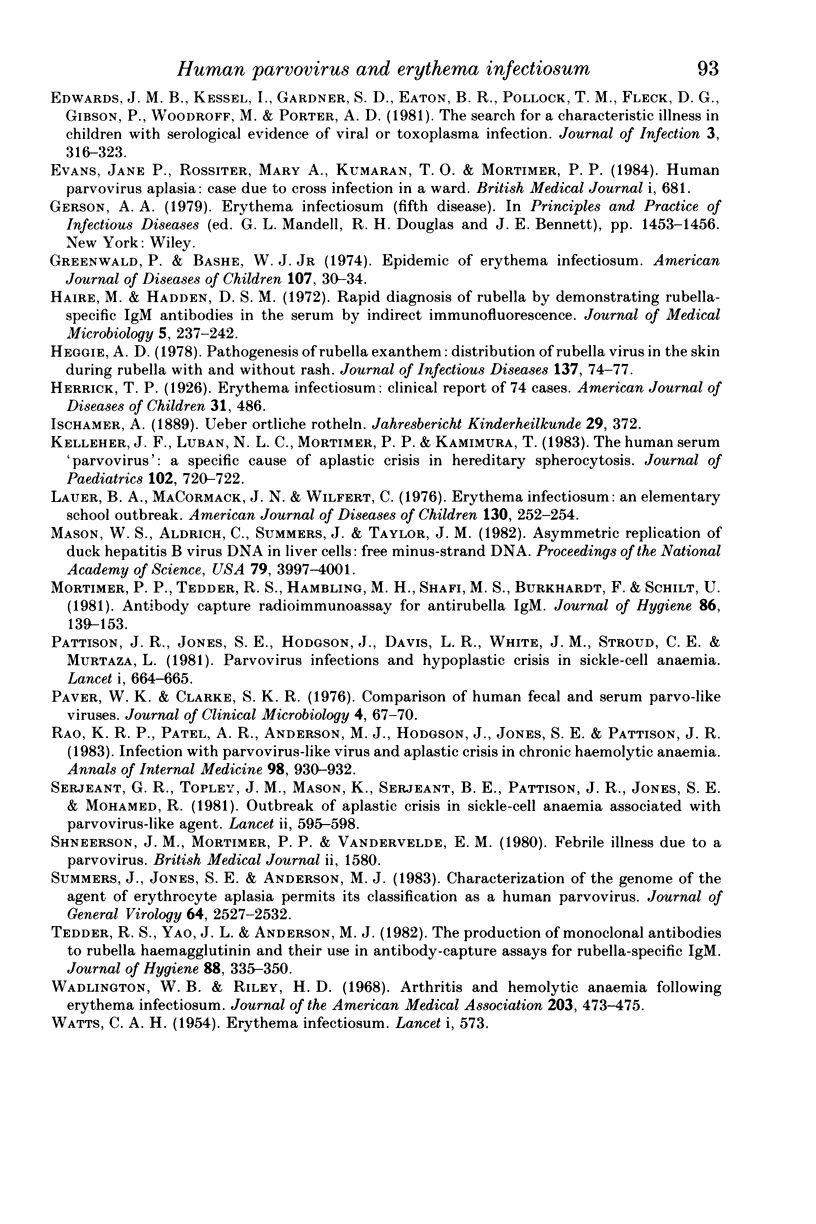Abstract
Erythema infectiosum (EI) or fifth disease is a mild, acute exanthematous disease, occurring mainly among children, for which a causative virus has long been sought. In May 1983 an outbreak of exanthematous illness was reported in a primary school in North London. Children attending the school were investigated by questionnaire and 162 (43.9%) reported an illness with the features of EI. In each of 36 cases investigated virologically the illness was associated with parvovirus infection. Moreover, pre-existing antibody to parvovirus was correlated with protection from EI in 16 of 17 close family contacts of cases. We propose therefore that EI is the common manifestation of infection with the human parvovirus.
Full text
PDF








Selected References
These references are in PubMed. This may not be the complete list of references from this article.
- Ager E. A., Chin T. D., Poland J. D. Epidemic erythema infectiosum. N Engl J Med. 1966 Dec 15;275(24):1326–1331. doi: 10.1056/NEJM196612152752402. [DOI] [PubMed] [Google Scholar]
- Anderson M. J., Davis L. R., Jones S. E., Pattison J. R., Serjeant G. R. The development and use of an antibody capture radioimmunoassay for specific IgM to a human parvovirus-like agent. J Hyg (Lond) 1982 Apr;88(2):309–324. doi: 10.1017/s0022172400070169. [DOI] [PMC free article] [PubMed] [Google Scholar]
- Balfour H. H., Jr Fifth disease: full fathom five. Am J Dis Child. 1976 Mar;130(3):239–240. doi: 10.1001/archpedi.1976.02120040017002. [DOI] [PubMed] [Google Scholar]
- Balfour H. H., Jr, May D. B., Rotte T. C., Phelps W. R., Schiff G. M. A study of erythema infectiosum: recovery of rubella virus and echovirus-12. Pediatrics. 1972 Aug;50(2):285–290. [PubMed] [Google Scholar]
- Cohen B. J., Mortimer P. P., Pereira M. S. Diagnostic assays with monoclonal antibodies for the human serum parvovirus-like virus (SPLV). J Hyg (Lond) 1983 Aug;91(1):113–130. doi: 10.1017/s0022172400060095. [DOI] [PMC free article] [PubMed] [Google Scholar]
- Cossart Y. E., Field A. M., Cant B., Widdows D. Parvovirus-like particles in human sera. Lancet. 1975 Jan 11;1(7898):72–73. doi: 10.1016/s0140-6736(75)91074-0. [DOI] [PubMed] [Google Scholar]
- Cramp H. E., Armstrong B. D. Erythema infectiosum: an outbreak of "slapped cheek" disease in north Devon. Br Med J. 1976 Apr 10;1(6014):885–886. doi: 10.1136/bmj.1.6014.885. [DOI] [PMC free article] [PubMed] [Google Scholar]
- Duncan J. R., Potter C. B., Cappellini M. D., Kurtz J. B., Anderson M. J., Weatherall D. J. Aplastic crisis due to parvovirus infection in pyruvate kinase deficiency. Lancet. 1983 Jul 2;2(8340):14–16. doi: 10.1016/s0140-6736(83)90005-3. [DOI] [PubMed] [Google Scholar]
- Edwards J. M., Kessel I., Gardner S. D., Eaton B. R., Pollock T. M., Fleck D. G., Gibson P., Woodroof M., Porter A. D. A search for a characteristic illness in children with serological evidence of viral or toxoplasma infection. J Infect. 1981 Dec;3(4):316–323. doi: 10.1016/s0163-4453(81)91863-6. [DOI] [PubMed] [Google Scholar]
- Evans J. P., Rossiter M. A., Kumaran T. O., Marsh G. W., Mortimer P. P. Human parvovirus aplasia: case due to cross infection in a ward. Br Med J (Clin Res Ed) 1984 Mar 3;288(6418):681–681. doi: 10.1136/bmj.288.6418.681. [DOI] [PMC free article] [PubMed] [Google Scholar]
- GREENWALD P., BASHE W. J., Jr AN EPIDEMIC OF ERYTHEMA INFECTIOSUM. Am J Dis Child. 1964 Jan;107:30–34. doi: 10.1001/archpedi.1964.02080060032005. [DOI] [PubMed] [Google Scholar]
- Haire M., Hadden D. S. Rapid diagnosis of rubella by demonstrating rubella-specific IgM antibodies in ther serum by indirect immunofluorescence. J Med Microbiol. 1972 May;5(2):237–242. doi: 10.1099/00222615-5-2-237. [DOI] [PubMed] [Google Scholar]
- Heggie A. D. Pathogenesis of the rubella exanthem: distribution of rubella virus in the skin during rubella with and without rash. J Infect Dis. 1978 Jan;137(1):74–77. doi: 10.1093/infdis/137.1.74. [DOI] [PubMed] [Google Scholar]
- Kelleher J. F., Luban N. L., Mortimer P. P., Kamimura T. Human serum "parvovirus": a specific cause of aplastic crisis in children with hereditary spherocytosis. J Pediatr. 1983 May;102(5):720–722. doi: 10.1016/s0022-3476(83)80243-1. [DOI] [PubMed] [Google Scholar]
- Lauer B. A., MacCormack J. N., Wilfert C. Erythema infectiosum. An elementary school outbreak. Am J Dis Child. 1976 Mar;130(3):252–254. doi: 10.1001/archpedi.1976.02120040030006. [DOI] [PubMed] [Google Scholar]
- Mason W. S., Aldrich C., Summers J., Taylor J. M. Asymmetric replication of duck hepatitis B virus DNA in liver cells: Free minus-strand DNA. Proc Natl Acad Sci U S A. 1982 Jul;79(13):3997–4001. doi: 10.1073/pnas.79.13.3997. [DOI] [PMC free article] [PubMed] [Google Scholar]
- Mortimer P. P., Tedder R. S., Hamblig M. H., Shafi M. S., Burkhardt F., Schilt U. Antibody capture radioimmunoassay for anti-rubella IgM. J Hyg (Lond) 1981 Apr;86(2):139–153. doi: 10.1017/s0022172400068856. [DOI] [PMC free article] [PubMed] [Google Scholar]
- Pattison J. R., Jones S. E., Hodgson J., Davis L. R., White J. M., Stroud C. E., Murtaza L. Parvovirus infections and hypoplastic crisis in sickle-cell anaemia. Lancet. 1981 Mar 21;1(8221):664–665. doi: 10.1016/s0140-6736(81)91579-8. [DOI] [PubMed] [Google Scholar]
- Paver W. K., Clarke S. K. Comparison of human fecal and serum parvo-like viruses. J Clin Microbiol. 1976 Jul;4(1):67–70. doi: 10.1128/jcm.4.1.67-70.1976. [DOI] [PMC free article] [PubMed] [Google Scholar]
- Rao K. R., Patel A. R., Anderson M. J., Hodgson J., Jones S. E., Pattison J. R. Infection with parvovirus-like virus and aplastic crisis in chronic hemolytic anemia. Ann Intern Med. 1983 Jun;98(6):930–932. doi: 10.7326/0003-4819-98-6-930. [DOI] [PubMed] [Google Scholar]
- Serjeant G. R., Topley J. M., Mason K., Serjeant B. E., Pattison J. R., Jones S. E., Mohamed R. Outbreak of aplastic crises in sickle cell anaemia associated with parvovirus-like agent. Lancet. 1981 Sep 19;2(8247):595–597. doi: 10.1016/s0140-6736(81)92739-2. [DOI] [PubMed] [Google Scholar]
- Shneerson J. M., Mortimer P. P., Vandervelde E. M. Febrile illness due to a parvovirus. Br Med J. 1980 Jun 28;280(6231):1580–1580. doi: 10.1136/bmj.280.6231.1580. [DOI] [PMC free article] [PubMed] [Google Scholar]
- Summers J., Jones S. E., Anderson M. J. Characterization of the genome of the agent of erythrocyte aplasia permits its classification as a human parvovirus. J Gen Virol. 1983 Nov;64(Pt 11):2527–2532. doi: 10.1099/0022-1317-64-11-2527. [DOI] [PubMed] [Google Scholar]
- Tedder R. S., Yao J. L., Anderson M. J. The production of monoclonal antibodies to rubella haemagglutinin and their use in antibody-capture assays for rubella-specific IgM. J Hyg (Lond) 1982 Apr;88(2):335–350. doi: 10.1017/s0022172400070182. [DOI] [PMC free article] [PubMed] [Google Scholar]
- Wadlington W. B., Riley H. D., Jr Arthritis and hemolytic anemia following erythema infectiosum. JAMA. 1968 Feb 12;203(7):473–475. [PubMed] [Google Scholar]


